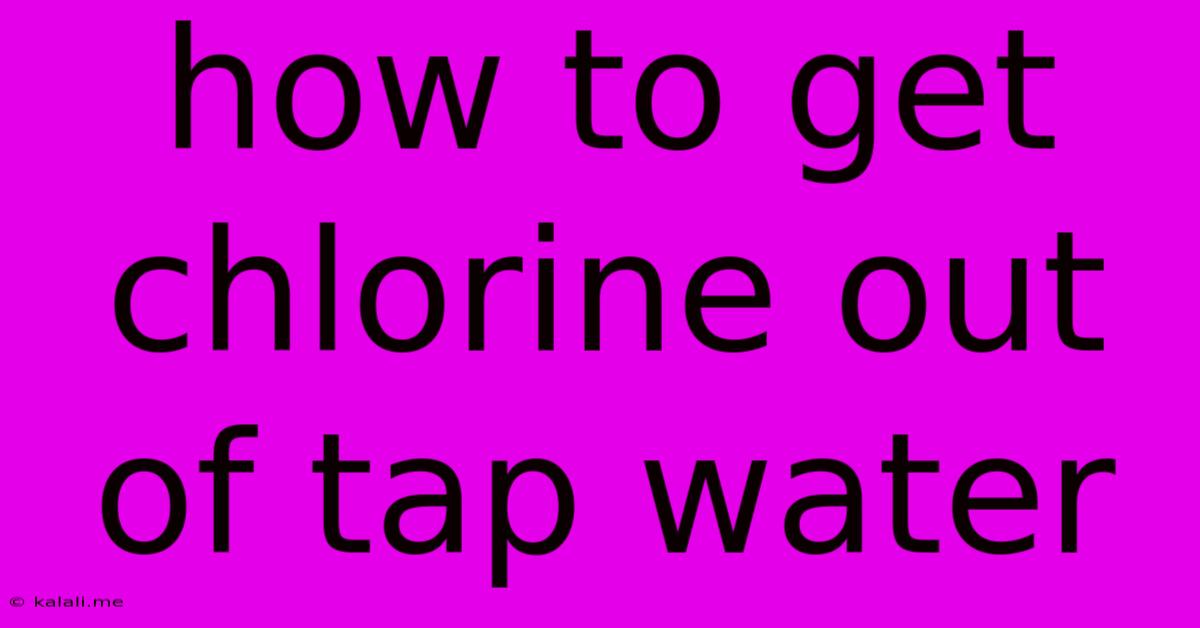How To Get Chlorine Out Of Tap Water
Kalali
Jun 03, 2025 · 3 min read

Table of Contents
How to Remove Chlorine From Tap Water: A Comprehensive Guide
Chlorine is commonly added to municipal water supplies to kill harmful bacteria and viruses, ensuring safe drinking water. However, many find the taste and smell of chlorine objectionable, and some worry about its potential long-term health effects. Fortunately, there are several effective methods to remove chlorine from your tap water, allowing you to enjoy a cleaner, fresher taste. This article explores various techniques, helping you choose the best option for your needs and budget.
Why Remove Chlorine from Tap Water?
While chlorine is beneficial for disinfection, its presence can negatively impact the taste and odor of your water, making it less palatable. Some individuals are also sensitive to chlorine, experiencing skin irritation or other allergic reactions. Furthermore, some people prefer the taste of chlorine-free water, believing it to be healthier. Although the levels of chlorine in treated tap water are generally considered safe, removing it offers a more pleasant drinking experience and caters to those with sensitivities.
Effective Methods for Chlorine Removal:
Several methods effectively remove chlorine from tap water, each with its pros and cons:
1. Boiling: A Simple, Quick Fix
Boiling water for a few minutes is a straightforward method to remove chlorine. The volatile nature of chlorine means it evaporates at high temperatures. This method is ideal for small quantities of water needed immediately. However, it's not practical for large-scale chlorine removal or for everyday use.
2. Activated Carbon Filtration: The Popular Choice
Activated carbon filters are highly effective in removing chlorine and other impurities. These filters use porous carbon materials that trap chlorine molecules, resulting in cleaner, better-tasting water. Activated carbon filters are available in various forms:
- Pitcher Filters: A convenient and affordable option for small households, these pitchers contain a replaceable activated carbon filter.
- Faucet-Mounted Filters: These filters attach directly to your faucet, providing filtered water on demand.
- Whole-House Filters: For comprehensive chlorine removal throughout your home, a whole-house filter is the most effective solution. This requires professional installation.
Activated carbon filters are a popular choice due to their efficiency and relative affordability. Remember to replace the filters according to the manufacturer's instructions to maintain effectiveness.
3. Water Distillation: A Purifying Process
Water distillation involves boiling water and then collecting the condensed steam. This process leaves behind impurities, including chlorine, resulting in purified water. While effective, distillation is energy-intensive and can be slow, making it less practical for daily use.
4. Reverse Osmosis (RO) Filtration: Superior Purification
Reverse osmosis systems use pressure to push water through a semi-permeable membrane, removing a wide range of contaminants, including chlorine. RO systems are highly effective, providing some of the purest water available, but they are also more expensive and require more maintenance than other methods.
5. Letting Water Sit: A Less Effective Approach
Simply letting tap water sit for several hours or overnight allows some chlorine to dissipate. However, this method is not very effective, and the chlorine removal is minimal. This is not a recommended method for anyone concerned about chlorine levels in their drinking water.
Choosing the Right Method:
The best method for removing chlorine depends on your budget, water usage, and desired level of purification. For occasional use and small quantities, boiling or using a pitcher filter is suitable. For everyday use and superior water quality, consider a faucet-mounted filter or a whole-house system. Reverse osmosis offers the purest water, but it’s a significant investment. Remember to always check the filter's specifications to ensure it effectively removes chlorine.
By understanding these methods, you can make an informed decision about the best way to remove chlorine from your tap water and enjoy cleaner, tastier, and healthier hydration.
Latest Posts
Latest Posts
-
What Are The Five Armies In The Hobbit Movie
Jun 04, 2025
-
Is It Bad For A Newborn To Watch Tv
Jun 04, 2025
-
Why Didnt Iroh Become Fire Lord
Jun 04, 2025
-
Water In Filter Area Of Dishwasher
Jun 04, 2025
-
The Needs Of Many Outweigh The Needs Of The Few
Jun 04, 2025
Related Post
Thank you for visiting our website which covers about How To Get Chlorine Out Of Tap Water . We hope the information provided has been useful to you. Feel free to contact us if you have any questions or need further assistance. See you next time and don't miss to bookmark.